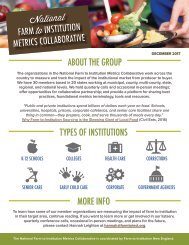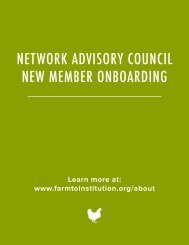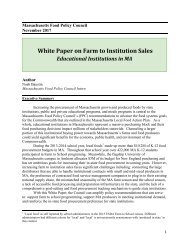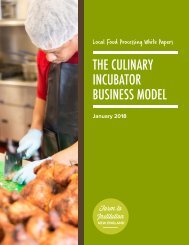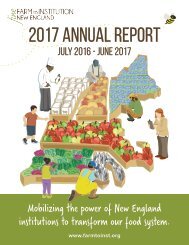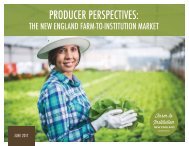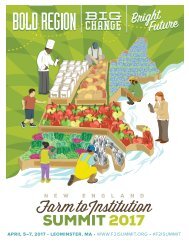FINE Food Safety White Paper
You also want an ePaper? Increase the reach of your titles
YUMPU automatically turns print PDFs into web optimized ePapers that Google loves.
Local <strong>Food</strong> Processing <strong>White</strong> <strong>Paper</strong>s<br />
FOOD SAFETY<br />
REGULATION<br />
AN INTRODUCTION FOR<br />
ENTREPRENEURS<br />
Nathaniel Brooks<br />
August 2017<br />
January 2018<br />
Farm to<br />
Institution<br />
NEW ENGLAND
THE EQUIPMENT<br />
QUESTION<br />
Author: Nathaniel Brooks Design: Kathleen Nay<br />
FARM TO INSTITUTION NEW ENGLAND<br />
Farm to Institution New England (<strong>FINE</strong>) is a six-state network of nonprofit, public and private entities<br />
working together to mobilize the power of New England institutions to transform our food system.<br />
Since its inception, <strong>FINE</strong> has focused on developing cross-sector connections between K-12 schools,<br />
colleges and universities, hospitals, and other institutions. Today, <strong>FINE</strong> serves those at the forefront of<br />
the farm to institution movement in the region, providing a forum to connect and share ideas, models,<br />
resources, and support.<br />
<strong>FINE</strong> leads projects related to key issues identified by farm to institution leaders and acts as the<br />
backbone organization for farm to institution work in the region: we strengthen the network, convene<br />
stakeholders, conduct research, develop tools and resources, and communicate with key audiences.<br />
NEW ENGLAND FOOD PROCESSORS COMMUNITY OF PRACTICE<br />
The New England <strong>Food</strong> Processors’ Community of Practice has provided a forum for processors of<br />
local food to share information, visit each other’s facilities, and develop collaborative solutions to<br />
common problems. The group has helped representatives from seven New England food processing<br />
facilities become better equipped to meet and overcome their challenges, and share what they are<br />
learning with other processors in New England and beyond.<br />
The major goals of the group were to help existing processing facilities become more efficient<br />
at processing local produce and meat for institutions and share best practices with new facilities.<br />
Participants have learned valuable information about topics like processing equipment, plant design,<br />
and food safety.<br />
This publication is part of a series of four white papers, which complements our suite of seven case<br />
studies featuring members of the New England <strong>Food</strong> Processors’ Community of Practice.<br />
Download these publications and watch an introductory video about the group:<br />
www.farmtoinstitution.org/processors<br />
www.farmtoinstitution.org
INTRODUCTION<br />
Hope & Main<br />
The regulation governing food manufacturing is complex, with overlapping jurisdiction, distributed<br />
enforcement, and significant variation by location. This confusion is compounded by ongoing changes<br />
at the federal level following the 2011 passage of the <strong>Food</strong> <strong>Safety</strong> Modernization Act (FSMA). This brief<br />
introduction is intended for entrepreneurs either exploring or starting a food manufacturing business.<br />
Because state and local regulation varies, the focus will be on understanding the interlocking structure<br />
of food safety regulation, particularly at the federal level, and identifying resources for interested<br />
readers to learn more. Alcoholic products are subject to separate regulation and are not covered by<br />
this introduction. 1<br />
The single most important thing for new entrepreneurs to understand about food safety regulation is<br />
that there are multiple, overlapping jurisdictions. Depending on the food products produced and the<br />
manufacturing location, a producer may be subject to local regulation, state regulation, and both <strong>Food</strong><br />
and Drug Administration (FDA) and US Department of Agriculture (USDA) oversight.<br />
1 Alcohol is subject to federal, state, and local regulation.<br />
The federal authority is the US Department of the Treasury<br />
Alcohol and Tobacco Trade Bureau (TTB). To learn more visit<br />
www.ttb.gov.<br />
Figure 1. The Interlocking layers of food safety regulation<br />
Vermont <strong>Food</strong> Venture Center, Hardwick VT<br />
FOOD SAFETY REGULATION: AN INTRODUCTION FOR ENTREPRENEURS<br />
3
FEDERAL FOOD SAFETY REGULATION<br />
The origins of federal food safety efforts date back roughly<br />
to the beginning of the 20th century. The USDA had<br />
been organized in 1862 by president Abraham Lincoln,<br />
but it wasn’t until the arrival of Harvey Washington Wiley<br />
as chief of the chemistry division in 1883 that consumer<br />
safety began to be a major focus. It was Wiley’s work on<br />
food adulterants, including “a series of ‘poison squad’<br />
experiments, in which able-bodied volunteers consumed<br />
varying amounts of questionable food additives to<br />
determine their impact on health” (Swann), along with<br />
the expose of Chicago’s meatpacking businesses by<br />
“muckracking” journalists such as Upton Sinclair, that<br />
spurred federal action on food safety. In 1906, the landmark<br />
passage of the Federal Meat Inspection act and the Pure<br />
<strong>Food</strong> and Drug Act laid the groundwork for the federal food<br />
safety system that endures today.<br />
Following the division of authority established by the<br />
1887 Interstate Commerce Act, federal regulation of<br />
manufactured products takes effect only when they are<br />
offered for sale across state lines: prior to that point, states<br />
are responsible for enforcement. This allows new food<br />
manufacturers the ability to undertake different levels<br />
of regulatory approval in sequence, first obtaining state<br />
approval, selling products locally as recordkeeping systems<br />
are refined and validated, then seeking federal approval.<br />
Upton Sinclair’s The Jungle. Wikimedia Commons.<br />
USDA<br />
Within the USDA, the <strong>Food</strong> <strong>Safety</strong> and Inspection Service (FSIS) is in charge of ensuring the safety of<br />
the following foods (“Investigations Operations Manual” p104):<br />
• Meat (cattle, sheep, goats, equines, and swine), poultry (chickens, turkeys, ducks, geese, guinea<br />
fowl, and ratites), and egg products (not shell eggs).<br />
• Products containing greater than 3% raw meat; 2% or more cooked meat or other portions of the<br />
carcass; or 30% or more fat, tallow or meat extract, alone or in combination.<br />
• Products containing 2% or more cooked poultry; more than 10% cooked poultry skins, giblets, fat<br />
and poultry meat in any combination.<br />
Any manufacturing establishment producing foods subject to FSIS oversight must obtain a grant of<br />
inspection, receive a registered plant number, and have labels approved prior to beginning production.<br />
The exception to this rule is an establishment that does not conduct slaughter and uses meat or poultry<br />
from USDA-inspected facilities to produce products solely for sale in-state. Such an establishment is<br />
subject to regulation by state authorities until the time at which products will be sold across state lines.<br />
FOOD SAFETY REGULATION: AN INTRODUCTION FOR ENTREPRENEURS<br />
4
Brief History of USDA & FSIS<br />
• 1862 USDA established by president Abraham Lincoln<br />
• 1906 Federal Meat Inspection Act passed by president Theodore Roosevelt, requiring continuous<br />
inspection of slaughterhouses and meat processing plants whose products are intended for<br />
interstate commerce.<br />
• 1957 Poultry Products Inspection Act passed, requiring poultry products shipped in interstate<br />
commerce to be continuously inspected, as well as establishing plant sanitation and labeling<br />
requirements.<br />
• 1965 USDA federal meat and poultry inspection merged into a single program under USDA<br />
Agricultural Research Service’s Consumer and Marketing Service<br />
• 1970 Egg Products Inspection Act (EPIA) passed, mandating continuous inspection of all liquid,<br />
frozen, and dried egg products<br />
• 1981 Following a decade of reorganizations, USDA meat and poultry inspection functions are<br />
consolidated into the newly-created <strong>Food</strong> <strong>Safety</strong> Inspection Service (FSIS)<br />
• 1995 Responsibility for egg product inspection is transferred to FSIS<br />
• 1996 FSIS issues Pathogen Reduction / HACCP systems rule, requiring the use of Hazard Analysis<br />
and Critical Control Point (HACCP) system in any facility processing meat products<br />
FDA<br />
Within the FDA, the Center For <strong>Food</strong> <strong>Safety</strong> and Applied Nutrition (CFSAN) is responsible for ensuring<br />
the safety of all domestic and imported food products not inspected by USDA FSIS, including all<br />
seafood, fish, and shellfish products. CFSAN maintains the Reportable <strong>Food</strong> Registry (RFR), an<br />
“electronic portal for Industry to report when there is reasonable probability that an article of food<br />
will cause serious adverse health consequences” (“RFR”) as well as a national registry of food<br />
manufacturers. Field staff, from the FDA’s Office of Regulatory Affairs, carry out inspections of regulated<br />
products and manufacturers and analyze product samples.<br />
Brief History of FDA & CFSAN<br />
• 1906 The Pure <strong>Food</strong> and Drug Act<br />
is passed by president Theodore<br />
Roosevelt. The Act prohibits, under<br />
penalty of seizure of goods, the<br />
marketing or interstate transport of food<br />
or drugs that had been “adulterated.”<br />
Responsibility for enforcement is given<br />
to the USDA Bureau of Chemistry,<br />
headed by Harvey Washington Wiley.<br />
• 1927 The USDA Bureau of Chemistry’s<br />
regulatory powers are reorganized<br />
under a new USDA body, the <strong>Food</strong>,<br />
Drug, and Insecticide organization.<br />
• 1930 The <strong>Food</strong>, Drug, and Insecticide<br />
Organization is renamed the <strong>Food</strong> and<br />
Drug Administration (FDA).<br />
• 1938 After more than 100 people die President Franklin Delano Roosevelt signing the 1938 Federal <strong>Food</strong>, Drug, and Cosmetic Act.<br />
FOOD SAFETY REGULATION: AN INTRODUCTION FOR ENTREPRENEURS<br />
5
from a toxic solvent used in sulfanilamide medication congress passes the Federal <strong>Food</strong>, Drug, and<br />
Cosmetic Act (FDCA), giving the FDA power to oversee the safety of food, drugs, and cosmetics.<br />
• 1940 The FDA is moved from being part of the USDA to being a part of the new Federal Security<br />
Agency<br />
• 1953 The FDA is moved again, to the Department of Health, Education, and Welfare<br />
• 1958 The <strong>Food</strong> Additives Amendment (to the 1938 FDCA) gives the FDA much tighter control over<br />
the amendments allowed in food<br />
• 1980 A new Department of Education was created, and the former Department of Health,<br />
Education, and Welfare became the Department of Health and Human Services, which continues to<br />
house the FDA<br />
• 2002 The Public Health Security and Bioterrorism Preparedness and Response Act requires all<br />
food manufacturers to register with the FDA and grants FDA power to review records and mandate<br />
detention of suspect food<br />
• 2011 The <strong>Food</strong> <strong>Safety</strong> Modernization Act (FSMA) grants the FDA additional regulatory powers,<br />
including mandatory recall authority<br />
Table 1. Comparing USDA and FDA Regulatory Enforcment<br />
USDA<br />
Products<br />
Meat, egg products, products containing<br />
more than 3% raw meat; 2%<br />
or more cooked meat or poultry<br />
FDA<br />
All food products not inspected by<br />
USDA FSIS, including shell eggs,<br />
products containing less than 3%<br />
raw or 2% cooked meat or poultry,<br />
and all seafood, fish, and shellfish<br />
products<br />
Inspected Entity Facility Business (if operating out of a<br />
shared facility, each business inspected<br />
separately<br />
Frequency of Inspection<br />
Continuous for slaughterhouses, Periodic (annually to more frequent)<br />
ongoing for food manufacturers<br />
(varies from daily check / records to<br />
review to continuous, depending on<br />
scale of production, past food safety<br />
record)<br />
Label Approval Required prior to sale Inspected and non-compliant products<br />
subject to enforcement<br />
Joint Jurisdiction<br />
When a manufacturer produces products subject to oversight by both the USDA FSIS and the FDA,<br />
a situation of joint jurisdiction exists. A simple example might be a facility that makes a line of pizzas:<br />
if the proportion of cooked meat in the pepperoni pizza exceeds 2% of the total product weight,<br />
that product falls under USDA jurisdiction. This would mean the facility would need to obtain a<br />
grant of inspection from the USDA, the label would need to be pre-approved by the USDA, and a<br />
USDA inspector would visit the facility any time the pepperoni pizza was being produced to monitor<br />
production practices and check records for compliance with the product’s HACCP plan. A vegetarian<br />
pizza made in the same facility would fall under FDA jurisdiction, and monitoring would take place only<br />
periodically. The result is that the pepperoni on the pepperoni pizza would be inspected three times<br />
(at the slaughterhouse, when the meat was made into pepperoni, and in the pizza-manufacturing plant)<br />
FOOD SAFETY REGULATION: AN INTRODUCTION FOR ENTREPRENEURS<br />
6
while the vegetarian pizza would most likely not be inspected at all. Surprising, but true. For some<br />
products, especially those that involve both meat and additives the determination can be even more<br />
complex. Sausages, for example, may be subject to joint jurisdiction because the meat is overseen by<br />
the USDA, while the nitrates, seasonings, and casing material are overseen by the FDA. See the FSIS<br />
and FDA memorandum of understanding on information sharing and determination of jurisdiction in the<br />
resources section for more information.<br />
President Obama signing FSMA into law on January 4th, 2011. Pete Souza https://www.flickr.com/photos/<br />
obamawhitehouse/5325468392/<br />
Changes Under the <strong>Food</strong> <strong>Safety</strong><br />
Modernization Act<br />
With the advent of the <strong>Food</strong> <strong>Safety</strong><br />
Modernization Act (FSMA), the<br />
FDA was charged with creating<br />
new science-based regulations to<br />
improve food safety. The major shift<br />
has been towards a preventionbased<br />
approach, emphasizing<br />
risk analysis and mitigation. The<br />
final rule with the most direct<br />
bearing on food manufacturers<br />
is “Current Good Manufacturing<br />
Practice, Hazard Analysis, and<br />
Risk-Based Preventive Controls for<br />
Human <strong>Food</strong>” (80 FR 55907, 2015)<br />
effective beginning November 16,<br />
2015. This rule requires registered<br />
food facilities to create and maintain a documented food safety plan, perform a hazard analysis, and<br />
institute preventive controls for hazard mitigation. Facilities also need to monitor hazard controls,<br />
periodically verify the controls are effective, take appropriate corrective actions when noncompliance<br />
is found, and maintain records documenting the corrective actions taken.<br />
Beyond updates to Good Manufacturing Practices and requiring a risk-based food safety management<br />
plan, FSMA contains a number of other provisions that impact food manufacturers:<br />
• The FDA is mandated to establish produce safety standards, and farms are required to institute<br />
preventive food safety controls (impacting supply chain).<br />
• The FDA is mandated to establish minimum inspection frequency for all food manufacturers, at<br />
higher-than-currently levels, and is granted the power to access all relevant records and the ability<br />
to require laboratory testing of certain foods.<br />
• The FDA is given the ability to declare a mandatory recall of potentially harmful food products in<br />
the market, as well as expanded powers of administrative detention (to hold suspect food), and the<br />
ability to revoke food facility registrations.<br />
Implementation dates for the different rules are staggered based on business size, but even the<br />
smallest businesses (less than $1 million in annual revenues) will be required to comply with new<br />
regulations by 2018. See “FSMA Rules and Guidance for Industry” in the resources section.<br />
FOOD SAFETY REGULATION: AN INTRODUCTION FOR ENTREPRENEURS<br />
7
STATE FOOD SAFETY REGULATION<br />
The authority for regulating businesses rests with individual states, and different states manage food<br />
manufacturing businesses in different ways. The Federal Meat and Poultry Inspection Acts require “as<br />
good as” regulation by state officials; beyond this minimum requirement, the process of inspecting<br />
and licensing food manufacturers is left up to the states. To outline the requirements of even a few<br />
states would be beyond the scope of this brief introduction. Entrepreneurs interested in starting a food<br />
business should consult the relevant authority in their state (see table below) for specific guidance.<br />
Note that the regulatory authorities listed below handle licensing of food manufacturers in the six New<br />
England states. Particular products (e.g., dairy and meat) may be subject to additional oversight by<br />
different state agencies.<br />
Table 2. State Regulatory Bodies Responsible for Licensing <strong>Food</strong> Processing Businesses<br />
State Office Phone Number Address<br />
Connecticut<br />
Department of Consumer Protection;<br />
<strong>Food</strong> and Standards Program<br />
(860) 713-6160 450 Columbus Boulevard,<br />
Hartford, CT 06103<br />
Massachusetts<br />
Health & Human Services, Department<br />
of Public Health; <strong>Food</strong> Protection<br />
Program<br />
(617) 983-6712 305 South Street,<br />
Jamaica Plain, MA 02130<br />
Maine<br />
Department of Agriculture, Conservation<br />
& Forestry; Division of Quality<br />
Assurance & Regulations<br />
(207) 287-3841 22 State House Station,<br />
18 Elkins Lane,<br />
Augusta, ME 04333<br />
New Hampshire<br />
Department of Health & Human Services;<br />
Division of Public Health Services,<br />
<strong>Food</strong> Protection Section<br />
(603) 271-4589 29 Hazen Drive,<br />
Concord, NH 03301-4604<br />
Rhode Island<br />
Department of Health; Office of <strong>Food</strong><br />
Protection<br />
(401) 222-2750 3 Capitol Hill,<br />
Providence, RI 02908<br />
Vermont<br />
Department of Health; <strong>Food</strong> & Lodging<br />
Program<br />
(802) 863-7220 108 Cherry Street,<br />
P.O. Box 70 - Drawer 30,<br />
Burlington, VT 05402-0070<br />
Mad River <strong>Food</strong> Hub, Waitsfield, VT<br />
FOOD SAFETY REGULATION: AN INTRODUCTION FOR ENTREPRENEURS<br />
8
LOCAL REGULATION<br />
Most localities require new businesses to obtain a business license, a process which typically includes<br />
a check that the proposed business doesn’t violate zoning ordinances for the proposed location. Some<br />
municipalities may also have regulations governing what types of food may be produced, restrictions<br />
on marketing, vending, or other specific rules. Boston, for example, banned the use of trans fats in<br />
food service establishments effective March 2009 (“Boston Trans Fat Ban”). Contact the city licensing<br />
bureau or town/county clerk’s office to access the specific requirements for your planned business and<br />
location.<br />
RESOURCES<br />
History<br />
• Johnson, Renee “The Federal <strong>Food</strong> <strong>Safety</strong> System: A Primer.”<br />
• FDA History<br />
• USDA FSIS History<br />
How-to<br />
• USDA Regulatory Compliance Resources and Information: A general resources page for producers<br />
subject to USDA regulation.<br />
• USDA AskFSIS: A question and answer portal regarding FSIS requirements and inspections.<br />
• FDA How to Start a <strong>Food</strong> Business: Overview of the food safety regulatory requirements, including<br />
an introduction to Good Manufacturing Practices (GMPs) and Hazard Assessment and Critical<br />
Control Point (HACCP) plans.<br />
• FSMA Rules & Guidance for Industry: A practical guide to understanding and complying with new<br />
FSMA regulations.<br />
Other<br />
• New England <strong>Food</strong> Entrepreneurs: A collective effort of various New England extension agencies,<br />
this site includes state-by-state information on licensing, training, organic certification, business<br />
development support, distributors, and more.<br />
• USDA FSIS and FDA MOU governing information sharing and jurisdiction: The official details of how<br />
USDA and FDA collaborate in cases of joint jurisdiction.<br />
FOOD SAFETY REGULATION: AN INTRODUCTION FOR ENTREPRENEURS<br />
9
REFERENCES<br />
Boston Public Health Commission. “Boston Trans Fat Ban.” http://www.bphc.org/whatwedo/healthy-eating-active-living/boston-trans-fat-ban/Pages/Boston-Trans-Fat-Ban.aspx.<br />
Accessed 12/6/2016.<br />
FDA. “FSMA Rules and Guidance for Industry.” http://www.fda.gov/<strong>Food</strong>/GuidanceRegulation/FSMA/<br />
ucm253380.htm. Accessed 12/6/16.<br />
FDA. “History.” http://www.fda.gov/AboutFDA/WhatWeDo/History/default.htm. Accessed 12/6/16.<br />
FDA. “Investigations Operations Manual.” 2016.<br />
FDA. “Reportable <strong>Food</strong> Registry.” http://www.fda.gov/<strong>Food</strong>/ComplianceEnforcement/RFR/default.htm.<br />
Accessed 12/6/16.<br />
Swann, John P. “FDA’s Origin.” http://www.fda.gov/AboutFDA/WhatWeDo/History/Origin/ucm124403.<br />
htm. Accessed 12/6/16.<br />
USDA FSIS. “FSIS History.” https://www.fsis.usda.gov/wps/portal/informational/aboutfsis/history. Accessed<br />
12/6/16.<br />
FOOD SAFETY REGULATION: AN INTRODUCTION FOR ENTREPRENEURS<br />
10




